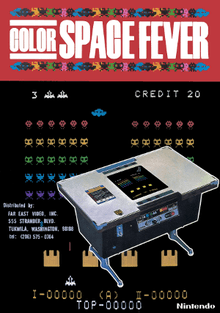Space Fever
| Space Fever | |
|---|---|
 Arcade flyer of Space Fever. | |
| Developer(s) | Nintendo R&D1 |
| Publisher(s) | Nintendo |
| Distributor(s) | Far East Video |
| Designer(s) | Nintendo |
| Platform(s) | Arcade game |
| Release date(s) | |
| Genre(s) | Fixed shooter |
| Mode(s) | Up to 2 players, alternating turns |
| Cabinet | Up-right, Cocktail |
| CPU | Z80 @ 3.072 MHz, I8035 @ 0.4 MHz |
| Sound | DAC audio |
| Display | Raster (Vertical) standard resolution (Used: 224×256) |
Space Fever (スペースフィーバー) is a 1979 arcade game by Nintendo R&D1. Some sources[1][2][3] claim that Ikegami Tsushinki also did design work on Space Fever. It was released in both monochrome and color versions. The gameplay is similar to Space Invaders, which was released by Taito in 1978. The game was distributed by Far East Video.
Gameplay
Similar to the gameplay of Space Invaders, Space Fever stars alien invaders who are attacking Earth. Player must shoot them out of the sky before they land, while avoiding each projectile shot by them. The alien craft are arranged in rows and they slowly move left and right across the screen. When the row reaches the edge, the ships drop down a row and move in the opposite direction.
Unlike Space Invaders, Space Fever has three different game modes, instead of one for 1- or 2-player games:
- Game-A: There are two horizontally-arranged "blocks" of aliens that move in opposite directions to, and "bounce" off each other.
- Game-B: The aliens move as one "block", but they initially only appear as a single row, with fresh rows gradually being added above the first as it moves down the screen; as it is essentially a single, never-ending "level", the shelter blocks are not replenished with each new wave as per games A and C.
- Game-C: Functionally identical to Space Invaders - the aliens move as a single "block" in the same direction.
As players shoot more enemies, the speed of them will increase, as will the number of their projectiles. Players have four shelter blocks above them that absorb the enemy shots until they are worn through, and being hit by an enemy shot will cost players a life. Players have three lives and once they lose all of them, the game is over. Sometimes a UFO will fly along the top of the screen and can be hit for a random amount of Bonus points.
Sequels
A special version of Space Fever called SF-Hisplitter (SFハイスプリッター), released the same year, features aliens double the width of the standard variety, which can either be destroyed completely or split into two smaller aliens depending on where they are shot. Not only the color version was colored, but also got the looks of its shelter blocks modified from the looks of the monochrome version's.
A sequel to Space Fever, known as Space Fever II (スペースフィーバーII) was built into the Game Boy Camera and acted both as a means of selecting the other built-in games, and as a game in itself. Space Fever II deviates from the Space Invaders formula, featuring instead smaller waves of individual aliens and bosses based on faces of Nintendo staff as well as the "game face" photo taken by the player.
References
- ↑ gdri.smspower.org
- ↑ ドンキーコング裁判についてちょこっと考えてみる Thinking a bit about Donkey Kong, accessed 2009-02-01
- ↑ It started from Pong (それは『ポン』から始まった : アーケードTVゲームの成り立ち sore wa pon kara hajimatta: ākēdo terebi gēmu no naritachi), Masumi Akagi (赤木真澄 Akagi Masumi), Amusement Tsūshinsha (アミューズメント通信社 Amyūzumento Tsūshinsha), 2005, ISBN 4-9902512-0-2.
External links
- Space Fever at the Killer List of Videogames (black & white version)
- Space Fever at the Killer List of Videogames (color version)
- Space Fever at NinDB